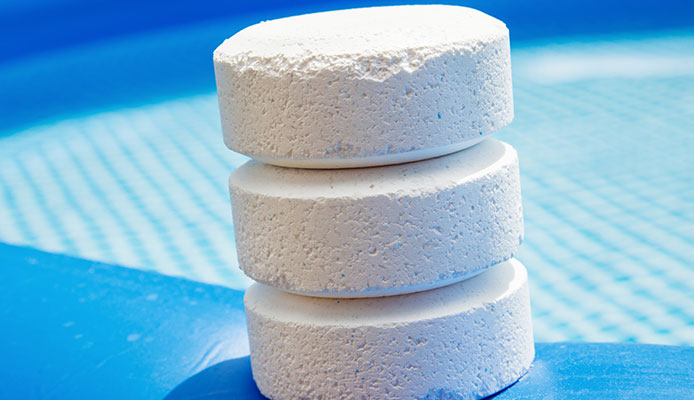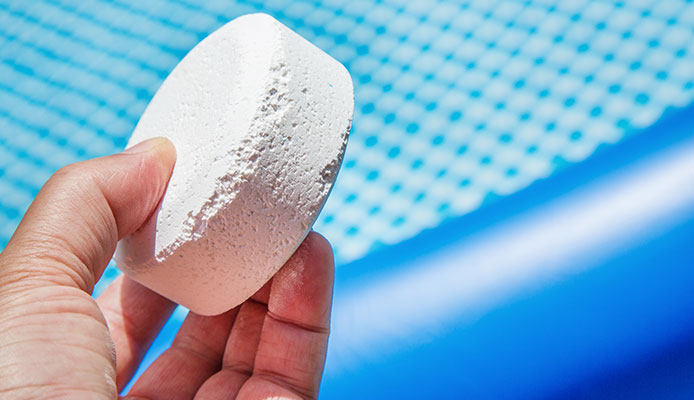
Chlorine lock is one of the most misunderstood terms among pool owners. This is a common problem that can result in under-utilizing chlorine in the swimming pool. There’s an on-going debate if this is a true phenomenon or if it is just a gimmick. In this guide, however, we assert that it is a true condition and you need to do something to prevent it from ruining water in your swimming pool.
To save money on your pool maintenance, you need to understand chlorine lock, and most importantly, how you can break it.
What is Chlorine Lock?
It happens when cyanuric acid (CYA) overpowers free chlorine in your swimming pool. While CYA is important in stabilizing water in the swimming pool, having too much can be a risk. It decreases the effectiveness of chlorine. The UV rays from the sun will break down chlorine easily, making the latter useless.
The imbalance of chlorine in your swimming pool can also happen as a result of having incorrect pH levels. The best pool test kits can help to make sure that the pH level is in check.
When chlorine block happens, several problems can be apparent. Bacteria and algae will be present in the swimming pool. Water will become visibly unclear. Your swimming pool will also end up being a breeding ground for mosquitoes. This can also translate into more expensive swimming pool maintenance costs.
Signs to Watch Out For
One of the most obvious signs you should watch out for is the smell of the water. If you notice that there is a strong smell of chlorine, this can be indicative of the presence of chloramines. They are the chemical compounds that build up in the pool water as a result of improper treatment.
Some might think that this strong smell is a sign that there is too much chlorine. However, there are instances when it is the other way around when there is an imbalance.
The signs will not always be obvious. As mentioned earlier, you need to test the pool water. Using pool test strips and other types of test kits will help identify the problem before it worsens. Aside from the pH level, you also need to measure total chlorine, free chlorine, and calcium hardness, among other things. You need to be technical to identify the presence of the problem and to execute the most effective solution.
How to Break a Chlorine Lock
When a chlorine block happens, there are several solutions that you can implement, including those that we’ll be briefly talking about below.
1. Partially Drain Your Swimming Pool
One of the easiest solutions is to drain water in the pool partially. This will be a refresher for the pool and will give it clean water. Check out this quick guide on how to drain an above ground pool very fast. For an in-ground pool, it can be quite trickier, but the process is almost the same.
A good practice is to drain the only ¼ of the water first. After this, test the water for chlorine. Repeat the process until the test shows that the total chlorine is equal to the free chlorine. Draining more water than necessary can lead to waste and higher expenses.
Before draining the water in the swimming pool, however, you need to backwash the filtration system. This will increase the level of freshwater in the pool. This process will clean the filter media.
2. Non-Chlorine Shock
To get rid of the chlorine block, another effective solution is a non-chlorine shock. This will oxidize the water in your swimming pool and restore balance. It will use active oxygen to get rid of contaminants in the water and restore its balance.
The success of this solution will depend on the amount of non-chlorine shock that you need to use. This isn’t a simple guessing game. Rather, you need to do a simple computation. First, subtract the free chorine from the total chlorine. You will then need to multiply it by the number of gallons in the swimming pool divided by 10,000 and multiply by 2. Below is a simplified version of the formula:
(Total Chlorine – Free Chlorine) x (No. of Gallons / 10,000) x 2
Based on the value derived from the formula above, add the necessary number of non-chlorine shock. Wait for a few hours, test, and repeat the process if necessary. Wait at least half an hour before you use the pool again.
You might also like: How Often And How Much Chlorine To Add To Pool
3. Chlorine Shock
If you are looking for the best ways how to shock a swimming pool to restore the balance of the chemicals, a chlorine shock is a must. Achieving breakpoint chlorination is an ideal solution for breaking the chlorine block.
To be more technical, breakpoint chlorination is the point where the chemical bond ties ammonia, chlorine, and nitrogen. As a result, the chlorine residual will drop. This is a technical process, but in most instances, you can accomplish this by following the same steps when you use a pool shock.
This requires the need to add a lot of chlorine to break the chloramine in the water. The first thing you need to do is to check the pH level in the water should be anywhere from 7.2 to 7.6.
If you are not sure about which type of shock is ideal for your pool, read this short comparison of chlorine vs non-chlorine shock.
A Word of Caution

When breaking the lock, it might seem logical that the best thing to do is to add more chlorine. However, this will only compound the problem. This will worsen the imbalance and can affect the cleanliness of your swimming pool water.
Instead of adding more chlorine, you need to remove some of the stabilizers to make sure that chlorine will be working as expected. This is why partial draining of water is recommended as mentioned earlier.
Globo Surf Overview
It is time to recognize chlorine lock as a true phenomenon and as a serious problem. Regularly test your water to prevent this issue. Otherwise, you will not be able to maximize the benefits of chlorine.
More Pool Chemistry Guides:
- How To Test Pool Water Without Kit?
- 10 Immediate Benefits Of Salt Water Pool
- Liquid Chlorine vs Tablets: Comparisson Guide

